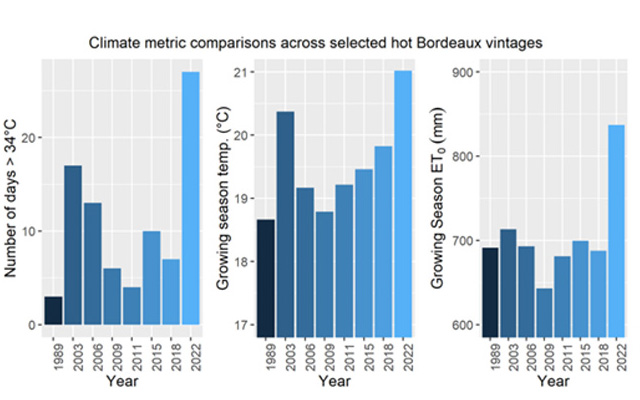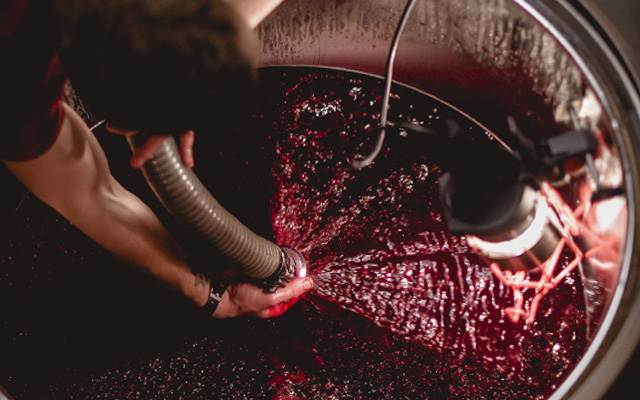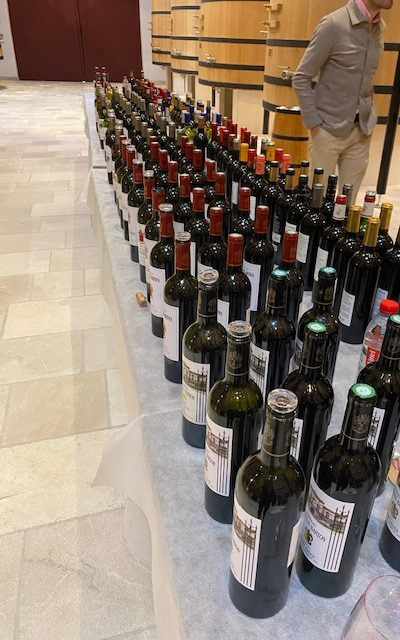As Édouard Moueix told us during our recent tastings in Bordeaux, 2022 was a year in which the sudden heat of May jolted flowering to life and ushered in a pattern of heat spikes – one in each of June, July and August – which provided the framework for a season like no other.
Taking the temperature
The mood in Bordeaux was excited and, with a refreshing absence of hyperbole, just a little bewildered. What is undeniable is that we have a seriously good vintage on our hands. What is less obvious is exactly how this came about. The high quality of the wines crept up by stealth, over the course of a season exhibiting the most marked ‘climate change’ phenomena yet seen. Whether by chance or design, or a combination of the two, Bordeaux 2022 is a story of success wrested from extreme conditions.

The growing season: off the charts
Part of this success is due to a newfound balance in vines which have become accustomed to hot, dry conditions. And part is down to a more sensitive, nuanced approach. In the vineyards, cover crops have turned the early spring vistas a hazy green where they were previously still brown at this time of year. In the cellars, you would be forgiven for thinking that no one practices extraction any more – the word infusion is near-ubiquitous, evoking a teabag dunked fleetingly in order to minimise harsh tannins.
Courtesy of Bordeaux-based journalist Jane Anson, the three graphs below show how the 2022 vintage is literally off the charts, outstripping even 2003, our most recent gold standard hot vintage.

Heat and the quest for freshness
The left-hand chart shows the number of days above 34°C. 2022 saw more than double those of any other modern hot vintage, other than 2003. It also rather dramatically consigns the ‘hot’ 1989 vintage to a different era.
The middle chart shows the average growing season temperature (rather than the heat spikes). On this measure, 2022 was a significant 1-2°C hotter than the rest. Pierre-Olivier Clouet of Cheval Blanc did not mince his words, saying of the heat and drought, “this [weather trend] is bad news for Bordeaux, a nightmare, which we should not be proud of.” (He has, incidentally, made a breathtakingly good wine in 2022, with a total absence of ‘solar’ character.)
How to retain freshness under such conditions? The relatively cool summer nights were cited by almost everyone we spoke to by way of (partial) explanation for the tangible zip in the 2022s. Growers are also becoming smarter with canopy management and, as mentioned, cover crops are now common. In 2022, some pHs remained relatively low, even with lowish acidity levels.
Two other factors we have seen in recent hot vintages are a concentration of acidity under drought conditions and a retention of tartaric acidity, even as the malic is depleted by the heat. And finally, there is a slowly building appetite for the Burgundian practice of whole bunch vinification and inclusion of stems, which can bring freshness. Les Carmes Haut-Brion and Château Rouget have both used this technique for some years now.
Water and where to find it
2022 was not the driest of recent vintages: as Alexandre Thienpont at Vieux Château Certan said, there was greater hydric stress in 2020 than 2022. It was also aided by full water tables going into the season thanks to the wet 2021. However, 2022 saw an abnormally high demand for water, driven by the heat. The right-hand chart shows the astonishing level of evapotranspiration, or overall water loss – evaporation from the soil plus transpiration from the vines.
Producers are attempting to mitigate against the growing drought threat: La Conseillante’s Marielle Cazaux has started mulching between the rows as a means of preventing evapotranspiration. Grapevines mitigate naturally as well: in 2022, the vegetative growth (shoots and leaves rather than grapes) of the vines was less than in 2021 and the berries were smaller, with thicker skins.
A more divisive issue is irrigation, which in 2022 was permitted in Pessac-Léognan, Pomerol and Saint-Émilion. Damien Barton Sartorius of Léoville and Langoa Barton told us that he “hated” irrigation, a view echoed by the Moueix family, for whom ‘dry farming’ has always been a given, even at their Dominus Estate in Napa. By contrast, Jean-Philippe Delmas of the Clarence Dillon Haut-Brion stable said he would irrigate if necessary, seeing it as no different to seeking the best sun exposure for your vines. A lively debate for the years to come.
Speaking at Pichon Baron, Christian Seeley of Axa Millésimes referenced the significant rainfall in June (after the first big heatwave of the summer) which helped, as did a couple of days of rain in August.
Although we didn’t feel 2022 to be either a ‘Cabernet or a Merlot vintage’, there is an undeniable loveliness to the 2022 Merlots. François-Xavier Maroteaux at Branaire-Ducru noted the greater proportion of Merlot relative to Cabernet Sauvignon in his blend this year, the château’s Merlot being planted on more clay-heavy soils, which are more water-retentive. This flourishing of Merlot in 2022 is a real point of difference with 2003, showing the extent to which viticulture (and perhaps vine adaptation) has moved on.
Harvest
Precision viticulture and smaller fermentation vessels have allowed greater fine-tuning of both picking and vinification. Château Ducru-Beaucaillou had 180 pickers at its disposal in 2022 which, in the context of the near-ideal harvest conditions, enabled an unhurried, highly targeted approach. Overall, picking was significantly earlier than in 2003.
As mentioned, extraction was generally very hands-off. One exception was Château Palmer, where Commercial Director Annabelle Grellier told us they “extracted firmly”, feeling that the vintage needed it.
The whites came in from mid-August: La Mission Haut-Brion and Haut-Brion were picked from 16th and 17th August respectively, and both were finished by the 23rd. The Merlot started in the first and second weeks of September, with the Cabernets in the second half of the month.
In Sauternes and Barsac, the first passes though the vineyards were made in late September, before botrytis had set in. Some rain and fog in early October then kick-started botrytis, which bloomed, allowing for highly concentrated sweet wines to be made thanks to the final passes in late October.

Yields
Smaller-than-normal berries meant overall yields in Pomerol and the Médoc communes of St-Estèphe, Pauillac, St-Julien and Margaux were lower than average in 2022. Saint-Émilion fared slightly better. However, the picture is more fragmented at the level of individual châteaux. Château Margaux’s yield was 25hl/ha, representing “35% less juice” in 2022. By contrast, the average 2022 yield in the Margaux commune was 32hl/ha, versus a long-term average of 40-45hl/ha. Haut-Brion came in at 32hl/ha in 2022, versus 42hl/ha in 2021. This made for 35% less grand vin than last year. François Mitjavile’s yields at Tertre Roteboeuf and Roc de Cambes were 40% lower than in 2021. The Sauternes crop, whilst better than the seriously tiny 2021, was still very small: 7hl/ha at Suduiraut (versus a paltry 1hl/ha in 2021).

The wines
William Kelley has called the 2022 vintage an “amplifier” – a year in which differences of site, grape variety and winemaking have been accentuated rather than masked with a veneer of fruit, as can occur in warm vintages such as 2018. Precision viticulture, with the ability to choose harvest dates with relative calm and vinify in small batches have made for red wines of panache and typicity. As noted, they have that crucial backbone of freshness to balance substantial (yet fine) tannins and firm (though generally not excessive) alcohol.
That tannic finesse may prove to be a hallmark of 2022. Tasting en primeur samples can be gruelling but even in the graveyard mid-afternoon slots, there were wines whose elegant, fruit-coated shapeliness was truly exciting, giving a glimpse of just how great they will be in maturity. For many estates, the 2022 reds will stake a claim to their best ever.
The whites had a tougher time of it. The heat has depleted their acidities, resulting in a lack of verve in places, as well as a tendency towards exotic fruit character. The exceptions, such as Domaine de Chevalier Blanc, Lions de Suduiraut Blanc Sec and Picque Caillou Blanc, stand out and should be snapped up.
While vintage comparisons are harder than ever (or perhaps more meaningless than ever) in such an atypical year, we are somewhere in the realm of 2019, 2016 and 2009. 2010 and 2005 were cited by the team at Lafite-Rothschild. For Édouard Moueix, 1982 is the reference point, for its low acidity and longevity. François Mitjavile said Tertre Roteboeuf 2022 is “in a bracket with the ‘85, ‘89, ‘97 and ‘09.” Taking refuge in the historical, Léoville Las Cases’s vintage booklet states simply, “This 2022 vintage reminds us of the 1870.”

The market (a plea for reason)
Larrivet Haut-Brion has fired a welcome early shot across the bows with a release price some 5% down on the 2021 vintage. In the context of a rather sticky secondary market, not to mention a precarious wider economy, this is to be applauded. Although we are realists and are as delighted as anyone by the high quality of the 2022s, we would also love to regain the buzz around the 2019 vintage which, whilst presented as a ‘Covid discount’, resulted in the most exciting en primeur season in over a decade.
As Damien Barton Sartorius put it when we spoke to him (look out for our interview online shortly), “Any wine released en primeur should be cheaper than any wine of a similar quality that’s available on the market.” We couldn’t have said it better ourselves.
Bordeaux, over to you – surprising prices for a surprising vintage, please…
Guy Seddon, May 2023

